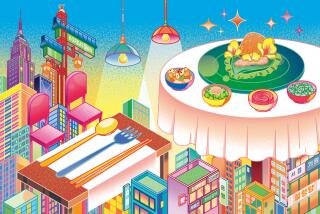Seoul museum holds an interesting brood in its fowl collection
- Share via
SEOUL — For years, Kim Cho-gang kept her oddball art collection out of sight, hidden away in a basement.
She admits hers is a rather unusual assemblage: wood carvings, paintings, puppets and embroidery -- all celebrating the lowly chicken. There are roosters and hens big and small, birds depicted clucking, scratching and crowing.
Since 2006, these works have had a public place to roost.
Setting aside her lifelong dream of opening a child-care center, the 70-year-old former public health professor runs the Seoul Museum of Chicken Art, a private facility containing all things fowl.
Kim is crazy about chickens, including their looks and their historical and cultural significance in countries across the world.
“I do not buy luxuries. I don’t buy cosmetics. I am only indulged in chickens,” said Kim, an elegant gray-haired woman with glittering chicken earrings and a multicolored rooster brooch. “Whenever I make money, I mostly spend it buying chicken art pieces.”
In 2000, the South Korean government passed a law that opened the door to for-profit private museums of all kinds. Since then, Seoul has become the home of a wide variety of private museums containing collections of what many might consider offbeat subjects.
There’s a museum dedicated to kimchi, one of Korea’s national dishes. There’s a dumpling museum, a sex museum, and showcases for rocks, masks, owls and traditional knots -- many in the same neighborhood as Kim’s museum.
“There are so many Koreans who are passionate about collecting,” said Kim In-whoe, president of the National Trust Cultural Heritage Fund of Korea. By opening a museum, he says, they can try to turn their passions into profits.
Kim Cho-gang’s gallery shows that the East and West have something in common when it comes to the chicken -- an emblem of luck, fertility and wealth across cultures.
The rooster was once within a whisker of being picked as the national bird of the U.S., Kim says. In Russia, she notes, chickens signify arrogance and in China, they are a symbol of the zodiac. In Korea, they represent wealth, fertility and protection from evil.
Kim got her start as a chicken icon collector decades ago when she came to the conclusion that the bird’s image wasn’t fully appreciated. She was taken aback to see puppet roosters burned as firewood in the countryside. Those roosters were originally attached to a traditional Korean funeral casket.
“I saved a few of the unlit puppet roosters and brought them to Seoul,” she said.
Kim collected chicken art while on vacation and during her academic travels. When she retired a few years ago, she decided to share her acquired knowledge of chicken culture.
Scholars say her fascination with chicken art is far from outlandish.
“The chicken is one of man’s universal livestock, absorbed in various cultures, but barely known,” said Kim In-whoe of the National Trust Cultural Heritage Fund.
The tiny Museum of Chicken Art, in a fashionable neighborhood not far from South Korea’s Constitutional Court, contains 2,000 exhibits. Many artists have donated or lent their works on the winged creature to the museum.
The art is not for sale, but Kim Cho-gang charges a small admission fee and sells souvenirs and postcards.
A brace of chicken sculptures from Mexico seems to cackle in a doorway while a roomful of chicken-shaped charms from Europe reflect light nearby.
There’s a display of bronze, wooden and porcelain fighting cocks from countries that ban cockfighting and those that regard the battles as national sport.
And there is a collection of the wooden roosters that got Kim started as a chicken arts expert: A showroom features kokdoo, bright sculptures that were once a common decoration on Korean funeral biers.
Yu Yeon-joon, a former art magazine writer and freelance photographer, marveled at the range of color at Kim’s museum. “If Picasso was alive, he’d extol flamboyance of chicken arts,” said Yu as he took in the gallery one recent morning.
But not every visitor to Kim’s chicken menagerie gets the point.
One walked in with an unusual question: Does the museum serve chicken soup?
--
Park is in The Times’ Seoul Bureau.
More to Read
Sign up for Essential California
The most important California stories and recommendations in your inbox every morning.
You may occasionally receive promotional content from the Los Angeles Times.










